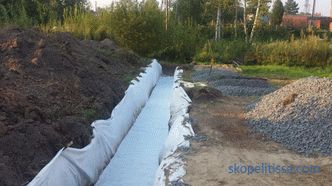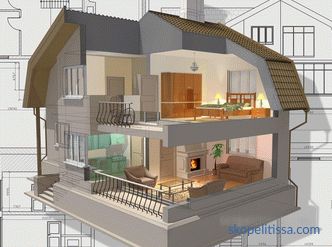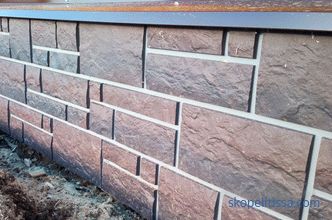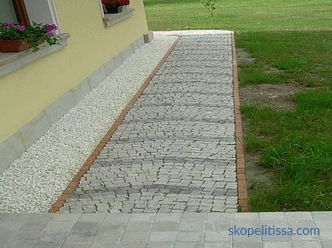In areas with a predominance of clay or marshy soils, it is advisable to equip the drainage system. It will help to avoid excessive wetting of the soil, increase yields, save the foundation of the house from natural soaking and premature destruction.
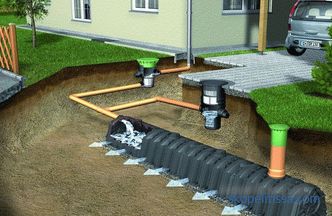
General scheme of drainage operation in the local area
How to determine the need for a drainage system
The surest sign of increased soil moisture is the massive growth of plants characteristic of the marshland. These include weeping willow, sedge, reed.
In addition to plants, the evidence of the close occurrence of groundwater will be puddles that remain after rain or spring thawing of snow. If they do not go down for a long time, then there is enough other moisture in the ground.
It does not always rain, so it is much easier to use a long-proven method of checking the level of soil moisture. To do this, you need to dig a hole about half a meter deep in the most elevated place of the site. If during the day at the bottom of the water will be collected, then this area needs drainage.
Varieties of drainage systems
There are several types of systems that can drain a site with a high level of groundwater. Before laying any of them, you should understand the methods of installation more carefully.
Types of surface drainage systems
Surface drainage of a site with a high level of groundwater at home and suburban areas is conventionally divided into two groups:
-
Linear. It is equipped by digging trenches on the surface of the soil around the perimeter of the site and serves to drain moisture from rain and snow. It functions smoothly only on smooth surfaces without a sharp relief drop. To do this, dig trenches with a depth of up to 30 cm and cover the walls with small gravel. The disadvantage of such a system is that it looks quite unaesthetic and needs constant cleaning from leaves, small debris.
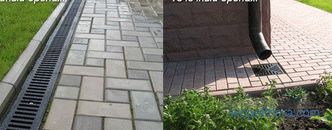
Elements of point and linear drainage
-
Spot. The simplest type of drainage is when water collectors are equipped in places of abundant discharge of water - under roof gutters, with small ravines.
The installation of such systems does not require special knowledge, design calculations, and happens "by eye".
Depth drainage system
In case the site is built on clayey soil, with a sharp drop in relief or in an area with abundant groundwater, deep drainage is required. It is quite complicated to install. To develop a system design, you need to contact a special bureau that provides geological prospecting services. Its specialists will accurately determine the level at which abundant aquifers pass and will help to competently cope with this problem.
Development of a drainage project
All deep-seated systems are built on the same principle. The project of site drainage is developed in such a way that all minor pipes for collecting moisture are connected to the central highway. It, in turn, ends in the main reservoir-receiving water or is displayed on the surface in a waste ravine.
Example of the operation of deep drainage in the video:
At the same time, the water intake should be located at the lowest point of the system. A very important point in the project should be the level and angle of the drainage pipes. In order to avoid silting or clogging, competent specialists will always suggest that the customer install inspection wells at each turn of the system. If necessary or after several years, the wells open and clean the pipes from debris under high pressure with water pressure.
Water intake is always placed below the ground freezing level. Typically, this mark varies in the range of 1-1.5 m.
Additional information! Perforated pipes are always selected for the installation of the drainage system. They suck up excess moisture from the ground with their surface and take it away from the site. A big mistake is that they use the same pipes to drain water from under the drains from the roofs. On the contrary, the abundant moisture from precipitation should be discharged into the central sewage system in a separate way and not be returned to the soil through the perforated drain. Otherwise, it will again fall into the ground and gradually begin to destroy the foundation of the structure.
Installation steps
After the detailed plan has been drawn up and all related factors have been taken into account, it is possible to proceed with the construction of drainage. Conventionally, it can be divided into the following stages:
-
The marking of the territory. Over the entire surface of the plot, with the help of a peg and a rope, they mark the future project.
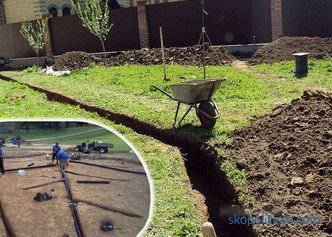
Marking and laying of drainage system pipes
-
Digging trenches. Ditches are dug to a depth of about 70 cm + 20 cm on the bottom seals. The width of the ditch varies within the width of the corrugations + 40 cm for freedom of occurrence.
-
Trench consolidation. The bottom of the trench is tamped down and covered with a layer of 10 cm of sand. A layer of fine crushed stone is poured from above.
-
Pipe installation. For deep drainage, it is best to use perforated plastic pipes. Recently, pipes wrapped with a special filter cloth have become popular. It is needed to prevent the system from clogging with sand. When cornering, in the places where the manholes are installed, holes are made in the pipes for the convenience of flushing the main line. During laying, you need to constantly monitor the level of inclination of pipes to the building level.
-
Falling asleep of the filter layer. To prevent premature silting, the laid pipes are covered with a new layer of rubble. From above lay a decorative layer of soil and level it well.
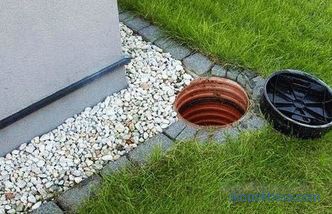
Ready drainage with intermediate well
-
Water intake device. In the lowest part of the site, the main tank is installed into which collected water from the central main will accumulate. Near the well, if necessary, install a pump for pumping water.
The collected water can be used for watering flower beds and other plantations in the dry season.
Drainage of an artificial pond
Some landscape designers suggest replacing the main water intake well with an artificial reservoir, thus decorating the site. The main disadvantage of this beautiful design solution is the risk of waterlogging in the man-made lake.
In this case, you should definitely install an additional pond drainage system separately. It is better to lay the bottom of it with a layer of small stone and sand and tamp it well. If the owner of the estate expressed a desire to cover the surface of the reservoir with foil, it is necessary to equip an additional well (gateway). His dig at a distance of about a meter from the pond and connect it with a pipe along the surface. In case of excessive filling of the main reservoir, excess moisture will be transferred to the additional reservoir. The water from the cleaning well as necessary pumped out.
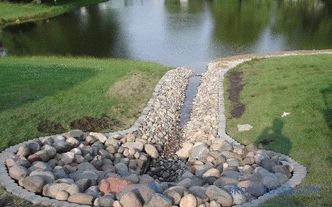
Decorating the drainage system for the lake
Also, do not neglect the simple and effective methods of draining the area. Trees or shrubs planted along the banks will naturally evaporate excess water through the leaves.
Drainage features, if the site is under a slope
Drainage on a site with a slope is carried out according to the standard procedure. The only difference is that all auxiliary pipes are mounted on the "herringbone" system in relation to the central highway. Without fail you need to monitor the correctness of the slope of the pipes. The water well, in this case, set in the lowest place of the site.
Price
If you have certain knowledge and experience, you can do the site drainage yourself. But only a well-planned drain will work correctly, timely and efficiently draining the site. Eliminate many mistakes, correctly calculate the angles of inclination and choose the best project for the consumption of materials, only experienced professionals can. It is worth noting that the preparation of a competent plan will help to avoid additional redevelopments in the future, which will significantly reduce the material costs of the backyard owner.
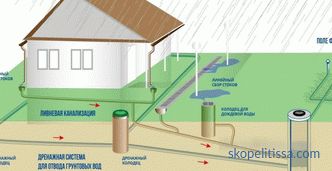
It is best when the drainage is designed with the house
The price of the finished project of the drainage system with installation depends on the size of the territory, the desired number of manholes, the complexity of the relief. The cost of the device turnkey drainage system starts from 1200 rubles per meter. Deep - from 2700 rubles per p. M.
Tips and recommendations
As practice shows, it is best to equip the deep and surface drainage at the same time. In this case, both systems will work simultaneously and with greater efficiency. Timely cleaning and proper care of the manholes and wells significantly prolong the life of the system and the integrity of the foundations of buildings.
It is necessary to take into account that the soil in the place of trenches will significantly shrink in the first season. Therefore, immediately decorate it with capital plantations is not worth it. It is better to survive at least one flood season and re-level the relief with an additional layer of earth.
To drastically reduce installation costs, the drainage pipes at the cottage can be replaced with a bunch of dry branches or a PET packaging structure.
It is clear what the drainage of the site is and how it works on the video:
As a result, at high groundwater levels water on the site, arrangement of the drainage system is not a luxury, but an urgent need. The cost of arrangement is low and in any case will pay for itself in a couple of seasons.
